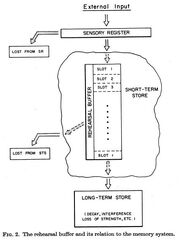43: The model that launched a thousand misconceptions! Atkinson & Shiffrin (1968) comprehensively summarized the memory literature and proposed that information is passed from brief sensory storage to short-term storage (via attention) and to long-term storage (via rehearsal). Their review remains impressive in its scope and clarity. Their theory is called the modal model because it emphasized modality-specific processing in sensory storage (visual stimuli to the icon, auditory to the echo, etc), STS and LTS. It might also be considered “modal” in the statistical sense (i.e., the mode, or most common): Variations on their model became the standard theory for decades, and the foundation for Baddeley and other contemporary memory theories.
An unfortunate effect of the influential modal model (thus called ‘the modal muddle’ by some) was the proliferation of “boxologies” of information processing, in which the serial rather than parallel nature of cognition was emphasized, and in which constructs like “the sensory store” and “short-term memory” were treated like actual things or places, rather than as shorthand for collections of behavioral phenomena.
Here’s a recent review I like: https://link.springer.com/article/10.1007/s10648-013-9246-y

The modal model, from Atkinson & Shiffrin's landmark review

A typical 'boxology' of the modal model